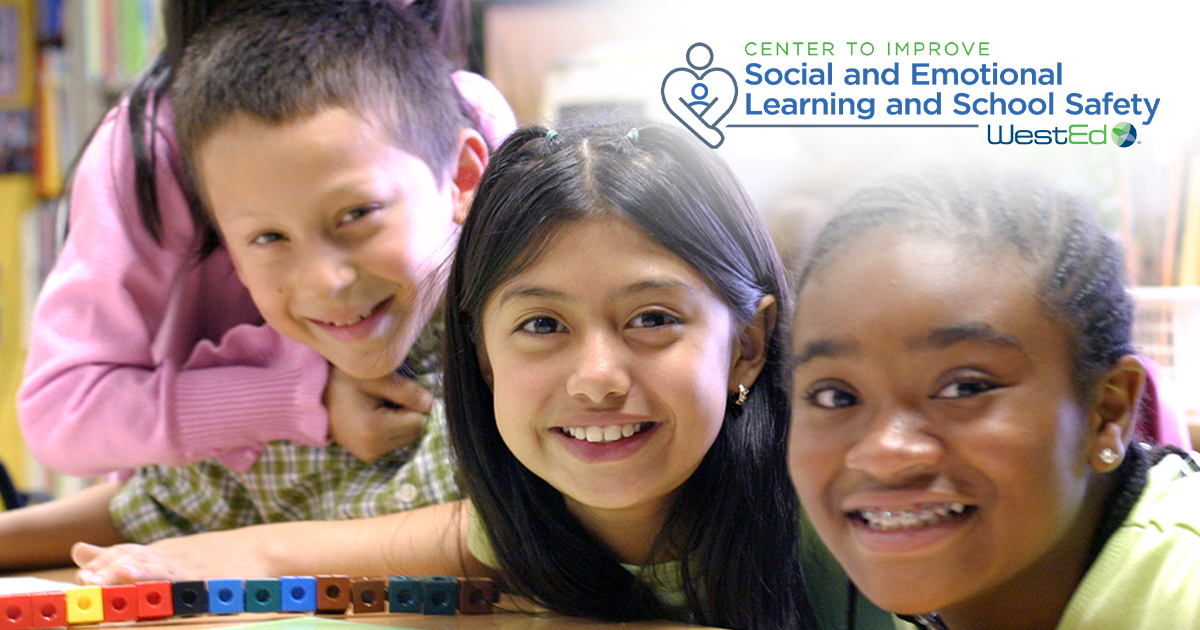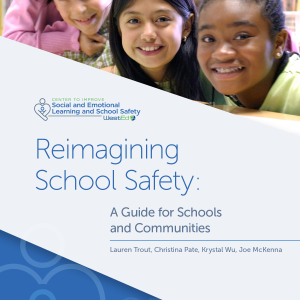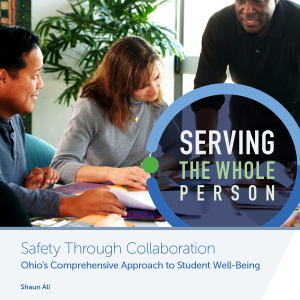A New Guide Sparks a Paradigm Shift Around Complex Issues of School Safety
Posted on

By Laura Buckner, Program Associate with WestEd’s Resilient and Healthy Schools and Communities. WestEd thanks Rachel Nelson of Bard Early College of New Orleans (BECNO) and the students from her Leadership and Social Change course for sharing their perspectives.
Reimagining School Safety: A Guide for Schools and Districts, a new interactive guide developed by the national Center to Improve Social and Emotional Learning and School Safety, aims to help education professionals reimagine and redefine school safety such that safety does not represent the absence of a negative but rather the presence of positive elements like interconnection, belonging, voice, and agency.
Further, working from this paradigm of safety and centering the lived experiences of students and families—especially those who have not traditionally had access to institutional power—can be a critical component of designing more equitable and sustainable systems.
In this post, WestEd’s Laura Buckner explores how the guide is used as part of the curriculum in one New Orleans classroom and how the work is helping to cultivate student leadership and a deeper understanding of what it means to be safe at school.
Leadership for Social Change
Rachel Nelson is an instructor at Bard Early College of New Orleans (BECNO), a satellite campus of Bard College that offers tuition-free college study to students for their last two years of traditional high school. BECNO students enroll from seven local high schools and are from communities that historically have not had access to liberal arts education.
In preparation for the most recent semester, Nelson was charged with developing a course based on the school’s efforts to encourage students to take a more active role in contributing to the school’s design and policies. Nelson envisioned a class that would grow students’ leadership skills in the context of their lived experiences and opportunities to embody transformational, community-driven social change.
That course, “Leadership for Social Change,” introduces second year students (seniors in traditional high schools) to community-focused leadership principles that emphasize the sharing of power and enacting positive social change.
Students learn about leadership frameworks and develop their personal leadership identities in the context of their school and local communities.
Toward A Clear, Holistic Understanding of School Safety
“Be brave. Try new things.” These instructions are not usually found on a typical high school class syllabus but then, Nelson’s class is anything but typical. Among the required texts on the syllabus is the Reimagining School Safety Guide.
Nelson chose to include the guide as an early reading for students because it provides a “clear, holistic understanding of school safety, and ties in with topics of social justice and identity,” which are key issues being addressed schoolwide.
As the class reads through the guide, Nelson encourages students to consider safety at their school and the complexities of how they, their peers, and school staff define and experience it.
We asked Nelson about her experience using the guide and how the work resonates with students.
How does the Reimagining School Safety Guide fit into your vision for teaching this class?
This class was designed in the context of reimagining our school community, especially around ideas of student leadership. The students had started asking for more voice and power on campus and in policy design, and we decided to create a class that helped them structure and organize what student leadership on campus could look like. What could it look like if we invited them into the process of community design as experts in their own experiences of justice, healing, and accountability?
What are some of the key takeaways you hope for your students—either related to the guide or for the class generally?
A lot of students are coming to Bard Early College from charter systems in New Orleans that prioritize really particular expectations for student behavior and have harsh penalization for perceived misbehaviors. I hope that my students start to develop strong muscles around organizing their fellow students and advocating with school or community leadership.
I also want them to understand how the microscopic (for example, how we treat each other in the halls) is so often mirrored at the policy level (how we respond to incidents of violence). Ultimately, I want them to have confidence in their ability to positively impact their school environment and a deep understanding that they deserve to feel safe, whole, and supported in their academic community.
What concepts have resonated for your students?
This guide has given my students (and me!) an easily digestible way to think about school safety and climate in a holistic way that feels deeply empowering for the students. This guide helps them couch their lived experiences in clear historical frameworks, as well as giving them strong language to discuss their experiences of inequity. It is a great balance of reflection while still being focused on action and solutions that feel achievable. My students are often excited to jump into conversations specific to our school after reading from the guide.
One thing that has really resonated for them is that in order to make different choices, they need to start thinking differently. The sense of the importance of a paradigm change is strong! They have loved the reflective questions, which ask them to respond with academic integrity when speaking about their own experiences.
What Students Are Saying
These quotes capture some of the key takeaways for Nelson’s students as they engaged with the content in the guide.
“I began to question if the term ‘safety’ even exists at this day in age. How can safety be spoken of when school authorities set fragmented standards of safety?” – Student
“The quote, ‘safety is not the absence of threat; it is the presence of connection’ (Stephen Porges) really resonated with me because it made me think about what safety looks like and means from person to person…and how implicit biases that educators interpret students’ behavior which shapes their viewpoints on who is deserving of safety and who is disrupting safety. The idea of racial discrimination embedded in the school safety system is a topic not talked about enough.” – Student
“I really like the idea of thinking that these strategies (in the guide) could lower violence rates if this was actually applied in school situations, such as de-escalating arguments before they can escalate to a fight and catch bullying in the beginning stage so that it doesn’t lead up to a child harming themselves or others. Proactive strategies instead of reactive strategies!” – Student
“Everyone doesn’t feel safe in their school environment, and the different approaches discussed are very helpful to address this. For example, the simple, complicated, and complex systems discussion was really helpful because I never really realized how different situations around safety calls for different approaches.” – Student
“Students often have the least power as it relates to decision making or being a voice of change within the school setting…We are expected to be accountability-bearers, however, we often cannot make our own decisions or even have a simple input especially when it comes to safety… The guide is valuable because it teaches students that they too can be a part of an empowered group that can make valuable decisions.” – Student
“When we think of school safety, it is filled with complex problems that will need to be addressed a little differently than we would a simple problem. We are dealing with real people that have real feelings that matter so it is important to be considerate of everyone in complex situations.” – Student
“When reimagining school safety, the idea of restorative justice and community-oriented approaches really resonates with me due to my past and current experiences in education. Being able to feel like you belong on a social level between peers and even with staff is very important to character development and safety… In my history of dealing with a very dismissive school to now being in a very active and restorative-community focused one, I feel much safer than before.” – Student
The next post in this series will dive deeper into how these concepts are shaping the students’ leadership journeys. Stay tuned. ♦
As a Program Associate for WestEd’s Resilient and Healthy Schools and Communities team, Laura Buckner translates research to practice and supports implementation of evidence-based practices in education. Buckner’s work centers on sharing information that is timely, relevant, and useful to education leaders as they seek to improve systems to address whole-person and whole-community needs. Bucker has written or co-written several guides for school and district administrators, including Calming Spaces in Schools and Classrooms.
The vision of the national Center to Improve Social and Emotional Learning and School Safety is that when all children are educated in places of equity, safety, and learning, and when they receive the integrated academic, social, and emotional supports that meet their individual needs, then they can achieve their greatest potential in K-12 education, as well as in college, career, and life.


